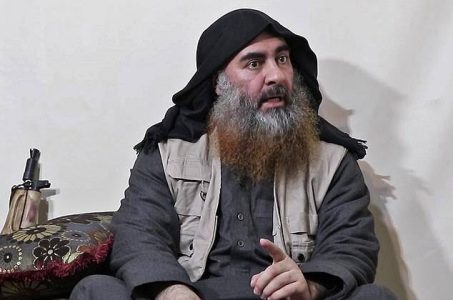
ISIS sex slave boss reveals how she helped CIA in hunt for terror group leader Abu Bakr al-Baghdadi
The woman who ran ISIS’s sex slavery network played a key role in the CIA hunt for Abu Bakr al-Baghdadi, it has been revealed.
Nisrine Assad Ibrahim, who is known as Umm Sayyaf, helped the intelligence agency and Kurdish forces in their efforts to track down the terrorist – pointing out safe houses, hideouts and where he could be in Mosul.
Umm Sayyaf has even predicted where al-Baghdadi is now, saying he liked Qaim or Bukamal in Iraq as he felt safer there than in Syria.
The 29-year-old was detained by US special forces during a raid in the ISIS-held Syrian city of Deir Ezzor in May, 2015, during which her terrorist husband Abu Sayaff was killed.
Senior defence experts said at the time Umm Sayyaf was cooperating with US officials and had provided the names and communication details of several senior ISIS commanders.
But the full extent of the Syrian’s collaboration has only now come to light, with her late husband’s closeness to al-Baghdadi having given her a good understanding of the terrorist leader, as well as rare access to ISIS meetings.
Umm Sayyaf was reluctant to help authorities to begin with from her cell in northern Iraq.
Yet a year after her capture, she helped the Americans with maps and photographs and even pinpointed a building in Mosul al-Baghdadi could be in.
But the US military – who later said he probably was there – did not bomb the house for fear of civilian casualties and due to heavy air traffic, Kurdish officials claimed.
Umm Sayyaf told the Guardian: ‘I told them where the house was. I knew he’d been there because it was one of the houses that was provided for him and one of the places he liked the most.’
She said of the Americans: ‘They were very polite and wore civilian clothes. I showed them everything I knew.’
The jihadi wife said she often saw the world’s most wanted man record propaganda videos in her home.
‘He used to do that in our sitting room in Taji [central Iraq]. My husband was the media chief then and al-Baghdadi would visit often.’
Umm Sayyaf helped the US and Kurdish forces and identified a safe house her aunt owned that al-Baghdadi was expected in.
She said: ‘Her name is Saadia Ibrahim.
‘Two of her sons have died with Isis. And she has been with al-Baghdadi since the beginning.
‘She runs the safe house network for him. She is the sister of my father.’
She said al-Baghdadi often went to see her in Syria when they lived in the town of Shadadah, where American aid worker Kayla Mueller was held for a month in 2014 before her death in Raqqa in February 2015.
Umm Sayyaf faces the death penalty after a court ruling in Erbil, Iraq, where she is being held by Kurdish intelligence.
But human rights lawyer – and wife to George Clooney – Amal Clooney called last month for Umm Sayyaf to be transferred to the US to face justice for her crimes against women – including those against Iraq’s Yazidi minority and Mueller.
Clooney, who represents Yazidi women and girls who were held in Umm Sayyaf’s house, told a UN Security Council meeting on sexual violence in conflict that the Yazidis were raped by ISIS men.
She said that Mueller ‘was held in brutal conditions for over 18 months and raped repeatedly’ by the militant group’s leader, al-Baghdadi.
‘Umm Sayyaf showed no solidarity with her fellow females. She locked them in a room, instigated their beatings and put makeup on them to ‘prepare’ them for rape,’ Clooney added.
Yet Umm Sayyaf strenuously denies this.
She said: ‘Whatever he [al-Baghdadi] did did not involve me.
‘Sometimes he would come for a few hours. Sometimes he would stay longer. It was just a normal house, and I provided him and my husband tea.’
Kurdish intelligence officers admitted Umm Sayyaf had been useful, adding she had given them a clear picture of al-Baghdadi’s family and the people around him.
But they said they would not release her as she would return to ISIS.
The special forces operation that caught Sayyah and killed husband Abu marked a turning point in the war on terror which finally came to an end in March in the remote Baghouz, Syria.
With Abu Sayaff believed to have been ISIS ‘oil minister’ and the man responsible for bringing a huge chunk of ISIS’ £2million a day income, his death stemmed the slow of cash to the now depleted terror group.
Source: Daily Mail





